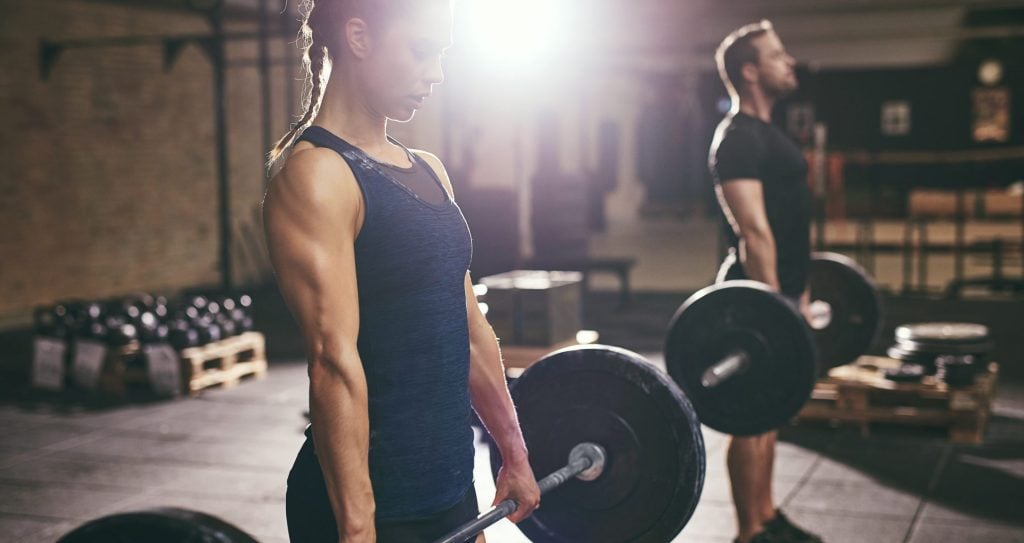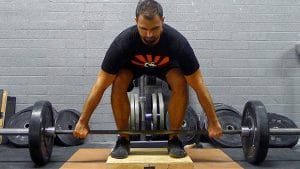Pause deadlifts improve your deadlift sticking points and put your posterior chain under more time under tension.
Deadlift variations like the deficit deadlift are exceptional exercises for strengthening your back and leg muscles (1). Nevertheless, as you perform this routine, you may notice a specific area of weakness during the lift, at the bottom, or just before the lockout, a.k.a. the sticking point. Enter the pause deadlift, an advanced variation of the deadlift that can potentially address and rectify any sticking points.
Compared to traditional deadlifts, pause deadlifts only require you to use a fraction of the weight to produce exceptional results. Learn why incorporating pause deadlifts into your workouts is crucial and master executing it effectively. In addition, explore a range of other outstanding deadlift variations to enhance your training experience further.
Techniques & Muscles Worked
Pause deadlifts work on your quads, glutes, hamstrings, erectors, adductor magnus, traps, lats, abs, rhomboids, and obliques. This exercise places more tension on your quads than conventional deadlifts, leading to more growth. Plus, the pause during the routine is an isometric contraction, which research shows can increase muscle hypertrophy and strength while reducing fatigue (2).
The movement of pause deadlifts is like conventional deadlifts, with a pause between the floor and your knee. You can use free weights like barbells, dumbbells, or kettlebells, but we’ll look at pause deadlifts with a barbell for this guide. Below are step-by-step instructions showing how to do pause deadlifts in proper form.
- Choose a weight lower than the traditional deadlift and place the barbell before you. The bar should be over the middle of your foot.
- Lean forward and grip the bar at shoulder-width distance using an overhand grip. This is your starting position.
- Bracing your abs, lift the bar, and pause for 1-3 seconds at the sticking point of a standard deadlift – just a few inches off the ground.
- Then, complete the lift by pulling the bar closer to your body as you rise. Pause when fully extended.
- Slowly lower the bar back to the starting position to complete the rep.
- Repeat for the number of reps you desire.
Benefits
For many athletes, the hardest part of the deadlift is the bottom of the pull when the bar gets off the floor (3). You can train your body to strengthen and overcome this deficiency by pausing during this variation. Below are other essential benefits of the pause deadlift.
Target Specific Muscles
While the pause deadlift will generally work on muscles in your upper, core, and lower body, you can further emphasize specific muscles. To do this, choose where you make your pause. Pausing just off the floor, for example, will increase your lower back muscle fibers.
Bigger Quads
Pause deadlifts put your quad muscles under greater tension than regular deadlifts, increasing muscle growth and size. The isometric contraction during the pause also increases tension in your quads.
Optimize Form
Pause deadlifts can help you work on the sticking points of the deadlift and improve your form overall. Improving your weak points can help improve your overall strength in those muscles, which will carry over to other exercises and strengthen your deadlifting strength.
More Joint-Friendly
The lower weight used during pause deadlifts means the exercise is more joint-friendly. Reducing the strain on your joints also means you get a lower injury risk while doing this routine.
Improved Explosive Power
Squats and deadlifts are great for building explosive power. However, the pause deadlift takes this to the next level because it forces you to push out of a paused position with explosive power.
Pause Deadlifts Alternatives
The pause deadlift is a compound exercise and a great addition to your workouts. You can use it to train and improve regular deadlifts while building your muscles better. Below are other efficient exercises that you can also use to improve your deadlift form.
Block Deadlifts
Block deadlifts are like pause deadlifts, but with assistance. During this routine, you set up blocks that stop at your deadlift’s sticking point. That way, you lift directly from this spot and reinforce the mechanics.
Deficit Deadlifts
With deficit deadlifts, you do your deadlifts on an elevated surface, increasing your range of motion during the movement. As a result, your muscles spend longer under tension, leading to more growth when performing deficit deadlifts.
Rack Pulls
While pause deadlifts can help you train sticking points between the floor and your knee, they aren’t much use for those with higher sticking points. With rack pulls, you can practice your lockout and other higher points of deadlifts.
FAQs
What are pause deadlifts good for?
They’re good for training sticking points during deadlifts. They also place your quads under great tension, increasing strength and muscle growth.
What is the difference between a deadlift and a pause deadlift?
During pause deadlifts, you pause the movement while doing the deadlift. This makes it more challenging than the regular deadlift.
How long should you pause deadlifts?
For maximum effect, you should pause for at least one second. However, this can feel longer when you are at the most challenging part of your lift and will be enough time under tension to stimulate your muscles. Note: You should start your count when you’re actually at a pause and not when slowing down on your way there.
Follow us on Instagram, Facebook, and Twitter for more exercise guides!
References
- Martín-Fuentes, I., Oliva-Lozano, J. M., & Muyor, J. M. (2020). Electromyographic activity in deadlift exercise and its variants. A systematic review. PloS one, 15(2), e0229507. https://doi.org/10.1371/journal.pone.0229507
- Lum, D., & Barbosa, T. M. (2019). Brief Review: Effects of Isometric Strength Training on Strength and Dynamic Performance. International journal of sports medicine, 40(6), 363–375. https://doi.org/10.1055/a-0863-4539
- Beckham, G. K., Lamont, H. S., Sato, K., Ramsey, M. W., Haff, G. G., & Stone, M. H. (2012). Isometric strength of powerlifters in key positions of the conventional deadlift. Journal of Trainology, 1(2), 32–35. https://doi.org/10.17338/trainology.1.2_32









